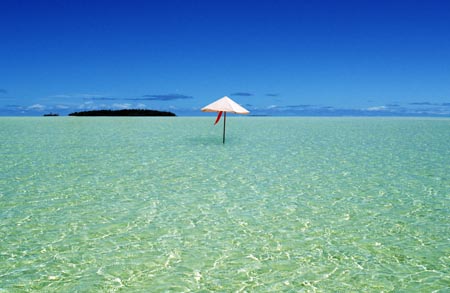The colour of the sea is determined by several factors, although two predominate. These are:
-
 Water absorbs the longer wavelengths of the visible spectrum, the reds, while allowing the shorter wavelengths (the blues) to penetrate to greater depths. The longer red wavelengths also scatter less readily than the bluer and shorter wavelengths. The colour of the light refracted, scattered and reflected from the surface has therefore had some of the red wavelengths removed and consequently tends towards blue. The amount of light reflected from water also depends upon the quantity and nature of the particles suspended in the liquid. Shallow coastal seas may contain a significant quantity of suspended phytoplankton, which gives the water a green hue. Deep clear water may contain much less suspended material, and the water may consequently appear much more blue.
Water absorbs the longer wavelengths of the visible spectrum, the reds, while allowing the shorter wavelengths (the blues) to penetrate to greater depths. The longer red wavelengths also scatter less readily than the bluer and shorter wavelengths. The colour of the light refracted, scattered and reflected from the surface has therefore had some of the red wavelengths removed and consequently tends towards blue. The amount of light reflected from water also depends upon the quantity and nature of the particles suspended in the liquid. Shallow coastal seas may contain a significant quantity of suspended phytoplankton, which gives the water a green hue. Deep clear water may contain much less suspended material, and the water may consequently appear much more blue. - The colour and brightness of the sky also have an effect because these change the colour of the light falling on the water, and hence affect the wavelength of the refracted and reflected rays. This effect can be seen by observing how the colour of the sea changes as the sky becomes overcast.
Another factor, which is easy to observe, is the nature of the material forming the sea bed. Where the sea bed is muddy or covered in vegetation, the water may appear grey or green. Where the sea bed is covered with whitish sand the water appears much more blue. The intensity of the blue colour depends to a large extent upon the depth of the water. In tropical areas the colours can be intense and very different in areas where the sea bed consists of coral or white sand. Finally, the position of the observer, and the elevation and azimuth of the Sun, also bring about perceived changes of colour. The smoothness of the surface of the sea is also a factor.






